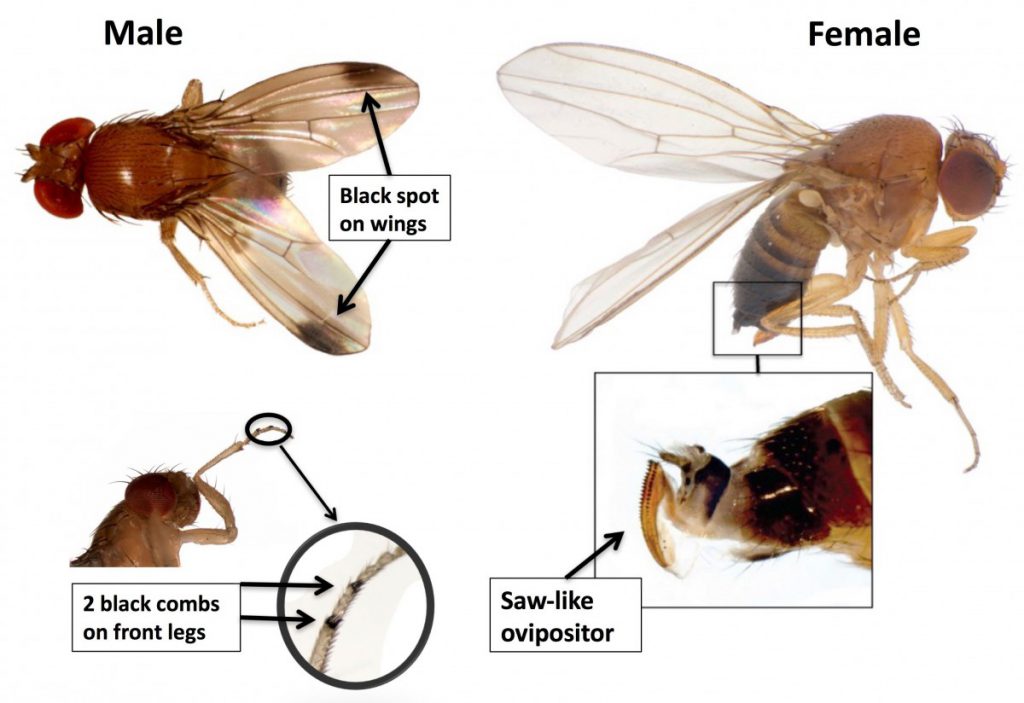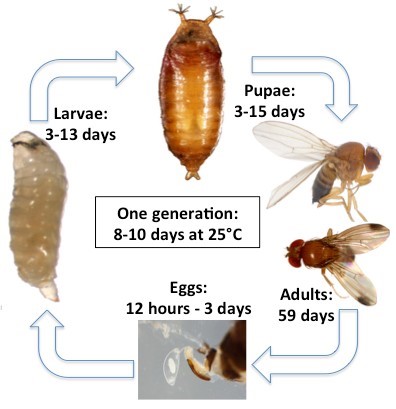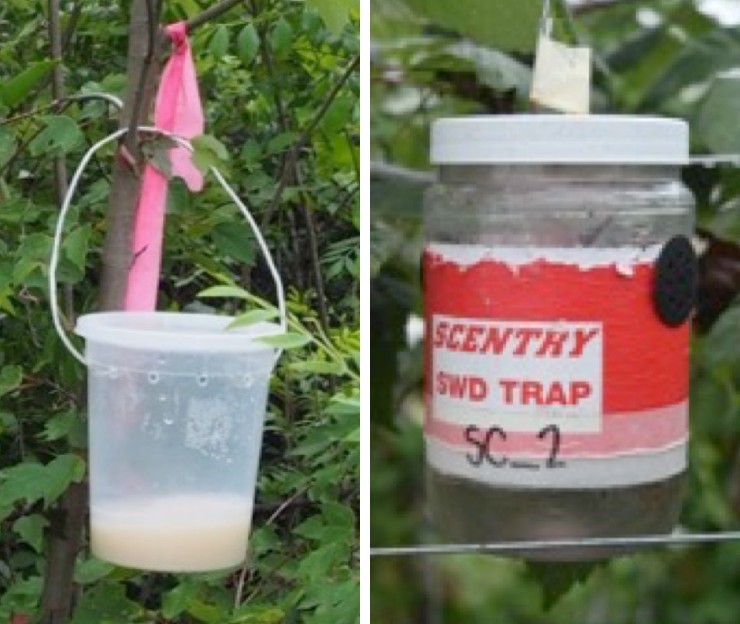Ashfaq Sial, Department of Entomology, University of Georgia, Athens, Ga.
Since its first detection in 2008, SWD has emerged as a devastating pest of berry and cherry crops throughout the United States. Male SWD have dark spots on the outer margins of their wings. Female SWD have a saw-like ovipositor that they use to cut the skin of ripe or ripening fruit and deposit eggs inside the fruit (Figure 1). Larvae (maggots) feed inside the berries and develop through three larval stages within the fruit causing the fruit to degrade (Figure 2). Larger larvae are visible to the naked eye, and if they are detected in the fruit, distributors may reject the contaminated loads of fruit. SWD injury also increases the risk of damage by other pests and fungal infections.


In regions with mild winter climates (e.g., Georgia, Florida, or other states in southern United States), SWD adults can be captured in traps year-round and can infest host fruit whenever they become ripe. However, in regions with harsher winters, SWD adults typically become active in mid-June to early July when temperatures are more suitable for population development. Females lay over 300 eggs which develop to adult flies in 8-10 days during the growing season, completing several generations per year (Figure 3). High populations build up over a short period of time, which makes SWD very problematic for small fruits. A wide host range, fast generation time, ability to lay eggs directly into the fruit, and larvae being sheltered from insecticide applications while feeding inside the fruit make this pest a challenge to manage.

A multi-regional team of researchers led by Dr. Ashfaq Sial, Associate Professor of Entomology at University of Georgia, has investigated behavioral, cultural, biological and chemical strategies to effectively control SWD. This team is funded by USDA NIFA through OREI program (Project # 2015-51300-24154 and # 2018-51300-24154).
SWD control programs should consist of three major components: 1) monitoring and identification, 2) the preventative pest management tactics (including exclusion, sanitation, frequent harvest intervals, pruning, mulching, and resistant varieties), and 3) the curative pest management tactics such as the judicious use of National Organic Program (NOP) approved insecticides or other responsive pest management tactics. In the case of SWD, insecticides are typically needed to maintain fruit quality on commercial farms, but organic growers should integrate cultural, physical and biological tactics into their SWD management programs as much as possible to help ensure effective control and prevent insecticide resistance development.
MONITORING AND IDENTIFICATION
An important component in the effective management of SWD is to determine when adult flies become active and the presence of larvae in the fruit. Monitoring should take place from early stages of fruit development until the end of harvest. Adult SWD can be monitored using traps. Larvae can be monitored by sampling and inspecting fruit. External fruit damage including soft spots or scarring on the skin, wrinkled skin, and collapsed areas on the fruit can indicate infestation. Leaky berries are another symptom, for example, infested raspberries often leave red patches of juice on the receptacle after picking.
To monitor adult SWD flies, you can use simple homemade traps or commercially available traps (e.g. Great Lakes IPM). A trap construction guide can be found at https://bit.ly/2Hgzz7C and a short video showing how to make this trap can be viewed at https://bit.ly/2qPBPrr. The traps must be baited to attract SWD. Homemade yeast-sugar based lures perform just as well as the commercially available Scentry lures. The yeast-sugar bait can be made by mixing 1 tablespoon of active dry yeast, 4 tablespoons sugar, and 1.5 cups of water. Alternatively, you can use a commercially available lure. The Scentry lure (Scentry Biologicals, Inc.) is a gel sachet that has catch rates comparable to the yeast-sugar bait but in a non-liquid formulation, allowing for less mess and easier identification of SWD. Non-liquid lures should be used with a 1” deep drowning solution of water containing a drop of unscented soap. The bait should be added to the trap to a 1” depth. Check traps weekly for SWD, record the catches, and replace the liquid bait or drowning solution. Commercial lures vary in longevity, but generally will last at least four weeks.
Spotted-wing drosophila lures are attractive to other insects, including other vinegar flies, so it is important to know how to identify SWD. Adult flies are small (~1/10 inch in length), and identification requires a 10x hand lens. Adult flies are golden brown in color and have red eyes. Male SWD can be identified from a single dark patch near the tip of each wing (Figure 1). Wing spots darken with age, so spots may not be apparent on young male SWD. Females lack wing spots but can be identified by their ovipositor, which is dark in color with small tooth-like serrations (Figure 1). A detailed SWD identification guide is available at https://bit.ly/2HjlczL. If you have difficulty identifying SWD, contact your crop consultant or local Extension agent.

Sampling for larvae in your fruit can help you determine fruit marketability and whether management actions are working. To sample from a planting, place at least 15 ripe fruit in a plastic bag. Lightly squeeze each fruit. Add in a strong salt solution (1 cup salt to 1 gallon water). The solution should be enough to cover all of the fruit in the bag. If they are present, small white SWD larvae will emerge and rise to the top of the liquid after 30 minutes. A more complete guide to the sampling process is available at https://goo.gl/bJf0CG and short videos describing various methods to sample fruit for SWD larvae can be viewed at https://bit.ly/2IZNZpc (salt solution), https://bit.ly/2qBlBC8 (sugar solution), and https://bit.ly/2JNs2uQ (boiling method).
If any SWD are found in traps or Drosophila larvae are found in the fruit samples, control actions should be taken immediately. Many growers begin insecticide applications as soon as one fly is detected in their field and the fruit are ripening or ripe. Implementing your cultural controls before this detection will help keep populations from growing quickly. It is also important not to delay responding to detection of infestation as SWD populations can build very quickly.
MANAGEMENT STRATEGIES
Based on research findings, implementation of the following strategies is recommended to effectively control SWD and protect fruit:
- Planting regionally appropriate early-ripening varieties and varieties with thicker-skinned fruit can help decrease the chances of SWD infestation.
- SWD adults are very sensitive to desiccation (drying out) and do not perform well at high temperatures and low humidity. Heavy pruning of blueberries will allow more light to penetrate through the canopy, which may lower humidity and increase temperature leading to less SWD infestation.
- SWD larvae often emerge from fruit to pupate in a suitable protected place, usually under the soil surface. Using black plastic weed mat as mulch on the ground provides an effective barrier that prevents larvae from pupating underneath the soil surface, reducing SWD survival in the field.
- Physically excluding SWD from the crop is very effective in preventing SWD infestation. Timely installation of insect netting to high tunnel infrastructure (side walls and ends of tunnels) provides a physical barrier to SWD. The netting needs to be rated at 80 grams or more to keep flies out. Studies have shown that adding 80 g insect netting to tunnel infrastructure (side walls and ends of tunnels) provides a physical barrier to SWD without affecting fruit marketability.
- Over-ripe and damaged fruit act as a reservoir for SWD and other pests in the field. Do not leave waste piles of fruit in the open. They should be bagged, burned or frozen. If bagging the fruit, use a clear trash bag and leave it in the sun for at least 48 hours to kill the larvae.
- SWD has a broad host range and will infest other non-crop plants, especially those that produce small fruits. A list of plants that can serve as SWD hosts is available at https://bit.ly/2JeVDwd. If these alternate plant hosts are present on the edge of the field, removing them could decrease the onset and severity of the SWD infestation.
- Ripe berries serve as a strong attractant for SWD. Frequent harvesting of the ripe fruit will decrease risk of SWD infestation in the fruit.
- Once SWD is detected in traps, insecticide applications need to be made to protect fruit from SWD infestation. Conventional management programs rely on the frequent use of pyrethroid, spinosyn, organophosphate, carbamate or diamide insecticides. Of these chemical classes, only the spinosyn insecticide spinosad is approved for use in organic systems. This means that other non-chemical control measures must be implemented to control SWD in organic berries. Among the organic insecticides, Entrust (spinosad) is the most effective but must be rotated with other insecticides to decrease resistance development and meet current label requirements. Products that can be used in a rotation program with Entrust include Pyganic, Grandevo, Venerate and Azera (See Tables 1 & 2 for further details about organically approved insecticide options for SWD management). Agricultural sanitizers such as Jet-Ag and OxiDate 2.0 used in tank-mix or rotation with insecticides also show some promise for use in organic integrated pest management programs.
- Spray coverage and timing of applications are critical to achieving good control. Sprayers should be calibrated at least annually, and appropriate spray volumes used to achieve excellent coverage. Initial research suggests that SWD are more active in the field during cooler parts of the day, in the morning and at dusk. Targeting sprays during these times may increase efficacy. When bees are present in the crop, avoid insecticide applications. If control is needed, use insecticides less toxic to bees and do not spray when they are active.
- After harvest, cool fruit as soon as possible to maintain quality. Cooling the fruit to 35°F for three days has been shown to kill SWD larvae. If fruit is sold directly to consumers, advise them to keep it in the refrigerator. Freezing the fruit will kill eggs and larvae of SWD.
Table 1: Entrust® SC Label Restrictions by Crop
| Crop | Blueberry | Raspberry, Blackberry | Strawberry | Stone Fruit |
| Application Rate | 4-6 fl oz / acre | 4-6 fl oz / acre | 4-6 fl oz / acre | 4-8 fl oz / acre |
| PHI | 3 days | 1 day | 1 day | 7 days |
| Retreatment Interval | 6 days | 5 days | 5 days | 7 days |
| Max Amount | 29 fl oz per year | 29 fl oz per year | 29 fl oz per year | 29 fl oz per year |
| Max No. of Applications | 6 per year | 6 per year | 5 per year | 3 per year |
Table 2: Organic Insecticides
| Trade name | Active Ingredient | Manufacturer | Effectiveness against SWD* |
| AzaGuard™ | Azadirachtin | BioSafe Systems | Poor |
| Azera® | Azadirachtin + Pyrethrins | Valent | Fair |
| Entrust® SC | Spinosad | Dow AgroSciences | Good |
| Grandevo® | Chromobacterium subtsugae | Marrone Bio Innovations | Fair |
| Pyganic® EC 1.4 | Pyrethrins | MGK | Fair |
| Venerate™ XC | Burkholderia spp. | Marrone Bio Innovations | Fair |
In summary, controlling SWD requires a rigorous, persistent and diverse management plan. Using as many control techniques as possible will help to reduce SWD infestation. Continue to evaluate your management program by monitoring SWD populations. Sample ripe and ripening fruit regularly to determine whether your management program is working and respond in a timely manner if needed. Always stay informed of your regional SWD pressure and new management techniques by contacting your local research and Extension personnel and utilizing the resources recommended by them.
More detailed information on organic management of SWD can be found in UGA Cooperative Extension Bulletin 1497 available at https://bit.ly/3bW6ERe.
References:
Sial, A. A., B. Little, C. Roubos, R. Isaacs, M. Grieshop, H. Leach, H. Bal, P. Fanning, S. Timmeren, C. Guedot, B. Jaffe, V. Walton, D. Rendon, D. Dalton, K. Hamby, A. Arsenault- Benoit, M. Rogers, A. Petran, O. Liburd, J. Spies, D. Johnson, F. Zalom, B. Gress, H. Burrack,
L. Diepenbrock, J. Lee, and T. Leskey. 2018. Management recommendations for spotted-wing drosophila in organic berry crops. UGA Cooperative Extension Bulletin 1497 (https://bit.ly/3bW6ERe).